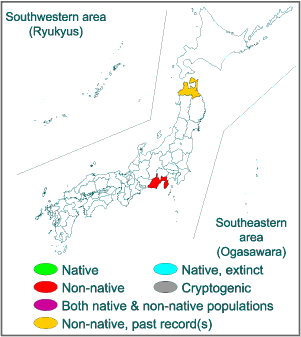
 Japanese |
English
Japanese |
English- Invasive Species of Japan >
- Mammals >
- Macaca cyclopis
| Invasion information | ||
| Range in Japan | Izuoshima Is. (Izu Islands), Onejima Is. (Shizuoka) and Wakayama Pref (declared eradication in 2017).
A population was established but eradicatiod in Shimokita Peninsula, Aomori Pref. |

|
| Origin | Taiwan | |
| Date | The first establishment was in 1940s at Izuoshima. In Wakayama, this species escaped from a zoo which bankrupt in 1954. In Onejima, this species was released in 1964. In Aomori, this species was imported in 1952 and farmed in open area since 1971. | |
| Route | Deliberate: Escape from zoo (Aomori, Izuoshima, and Wakayam), intentional release as a tourist attraction (Onejima). | |
| Impact | Hybridization. Damage on agriculture. Native organism(s) affected: Japanese macaque Macaca fuscata (hybridization), crops (orange, bamboo sprout, etc. in Wakayama; sweet potato, corn, camellia, etc. in Izuoshima). | |
| Regulation in Japan | Import, transport and keeping are prohibited in Japan by the Invasive Alien Species Act. | |
| Introduced range in other countries | None. | |
| Reference | Notes |
|
100 of the Japan’s Worst Invasive Alien Species. Macaca cyclopis × Macaca fuscata is Invasive alien species (Invasive Species Act) All the species of Macaca (except for M. cyclopis, M. fascicularis, M. mulatta, and M. fuscata) are designated as Uncategorized Alien Species by the Invasive Alien Species Act (import and keeping in Japan require 6 months investigation for risk assessment). In Wakayama, this species (including hybrids) have drastically declined by systematic control since 2002. Only 20 or less rhesus monkey may remain in 2009. Onejima population has declined despite no control, possibly because it is small (5ha) islands with poor vegetation. Izuoshima populations still remain to be abundant. |